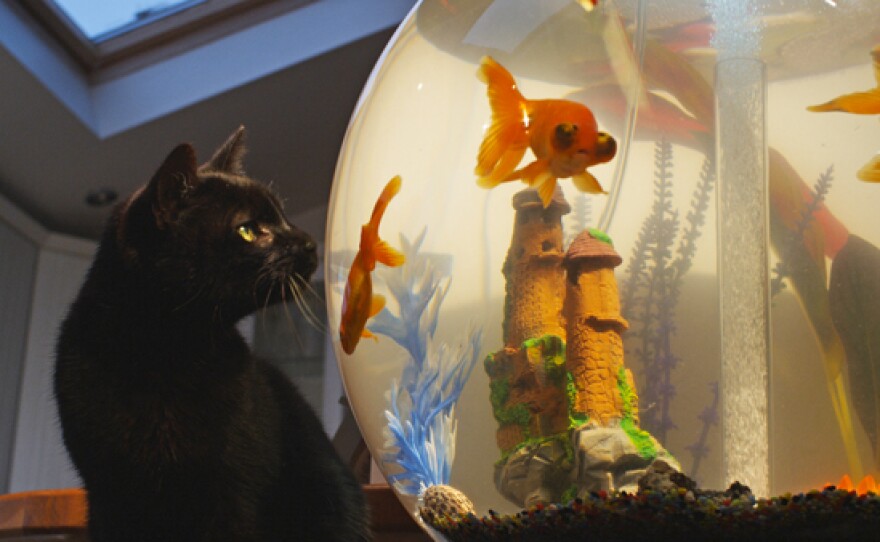—Most pet owners feel they understand their cat, dog or hamster. The two-part series reveals how our pets get in touch with their wild side.—
Pets are cute, loving and adored, with familiar behaviors that make them seem far removed from their wild counterparts.
But exactly why do hamsters love to run on a wheel, what are cat and mouse games really all about, and how do dogs know the rules of the pack?
While our pets may have been tame for thousands of years and made a successful transition to domestic life, they were wild for millions more, and their natural instincts remain intact, hiding in plain sight.
This two-part series, PETS: WILD AT HEART, delves into the secret world our pets inhabit, ruled by their intrinsic wild behavior, extraordinary senses and special skills.
Using spy cameras, moving x-rays, ultra slow-motion and thermal imagery, filmmakers uncover the hidden powers that pets possess.

EPISODE GUIDE:
EPISODE 1: "Playful Creatures," explores how pets get in touch with their wild side through play. In one example, seven-week-old Cockapoo puppies are shown jostling with each other, but there’s more than just play going on.
They are, in fact, rehearsing the same rules that enable wolves to hunt as an organized pack. Although dominant puppies fight the weaker ones, they learn to restrain their bite so no one gets hurt.
They may practice killer holds, but if a puppy rolls over exposing its vulnerable belly, that’s a signal to stop. If this rule is ignored, the offending puppy is ostracized.
In another segment, it is revealed that pet hamsters are almost addicted to their exercise wheels because they literally have to run – it’s in their genes.

Their need for speed can be traced back to the wild where hamsters have to outrun predators in order to survive.
But pet hamsters often run just for fun, for competition with one another, or to experience a runner’s high with its accompanying rush of endorphins.
Parakeets are hardwired to seek out company due to the extremely social nature of their wild equivalents that gather in large flocks and chat away all day long.
Wild parakeets also mimic each other and assign special calls to name their offspring.
Disco, the parakeet featured in the film, is a highly-skilled mimic and has memorized over 130 phrases.
EPISODE 2: "Secretive Creatures," depicts the hidden powers of pets and how they use their senses to communicate.
One storyline follows the nocturnal mission of a hamster in search of soft bedding material for his cage, in this case, toilet paper.
As the hamster moves, glands on his belly lay down a scent that leaves a sensory map he can follow with his heightened sense of smell. It will guide him home once his mission is accomplished.
But when it comes to the power of smell, dogs take the top prize. While humans have six million smell receptors, a dog’s nose contains 300 million.

Filmmakers use Schlieren photography, which makes smells visible, to visualize how dogs breathe.
It illustrates the unique two-way current that allows dogs to pick up a scent almost continuously.
They can zero in on those smells of special significance, such as picking up the scent of a female in heat.

The film also points out that cats, to a lesser degree, also have a strong sense of smell and can detect the scent of catnip in just one part per billion.
It only takes a few bites of this mind-altering plant for most cats to fall under its spell.
Even big cats, such as leopards and tigers, react in the same way.

Once we learn to recognize how our pets have learned to live alongside us, as part of the family, yet in very different worlds, we may never look at any of these amazing creatures in quite the same way again.
RELATED: VIEW SUBMITTED PHOTOS FROM YOUR PET’S WILDEST POSE CAMPAIGN
WATCH ON YOUR SCHEDULE:
This program is not currently available to stream on demand. The DVD is available to purchase at ShopPBS.org
Episodes of NATURE are available for streaming on demand for a limited time after broadcast. Extend your viewing window with KPBS Passport, video streaming for members ($60 yearly) using your computer, smartphone, tablet, Roku, AppleTV, Amazon Fire or Chromecast. Learn how to activate your benefit now.
JOIN THE CONVERSATION:
NATURE is on Facebook, Tumblr and you can follow @PBSNature on Twitter. #NaturePBS

CREDITS:
A John Downer Production for THIRTEEN Productions LLC and BBC in association with WNET. NATURE is a production of THIRTEEN Productions LLC for WNET. For NATURE, Fred Kaufman is executive producer.





